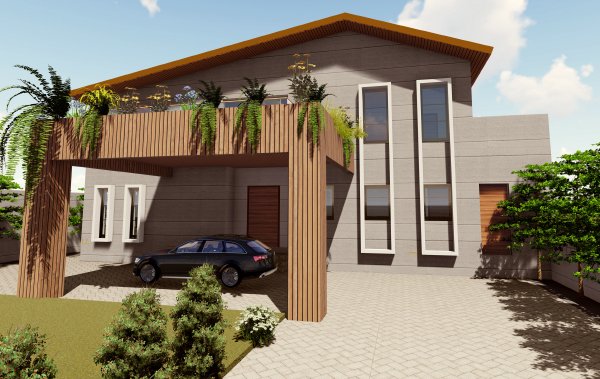PROJECT BRIEF
When one thinks of a villa, one might imagine a grand and luxurious home, complete with spacious rooms, elegant decor and stunning views of the surrounding landscape. This is exactly what was designed for the Mishrikotkar House, a perfect blend of exquisite design, comfort, style and functionality.
The small taluka of Deulgaonraja, located in the Buldhana district of Maharashtra, is known for its hot and dry climate, with temperatures soaring to over 44 degrees Celsius during the summer months. This presented a unique set of design challenges for the villa-style home, as it needed to be designed to withstand harsh weather conditions and provide a comfortable living environment for the Mishrikotkar family.
ARCHITECTURAL FEATURES
One of the most striking features of this house is the sloping roof make with terracotta that covers the porch, providing a warm and welcoming entrance to the property. Once inside, one is greeted by a spacious courtyard that divides the common spaces, including the living room, dining room, TV room and kitchen from the private bedrooms. The courtyard is a large and airy space, with plenty of natural light and ventilation to create a comfortable and inviting atmosphere.
One of the highlights of the courtyard is the puja space (worship area), a serene and peaceful zone that is perfect for meditation and prayers. The courtyard also features a deck that offers a stunning view of the horizon, perfect to revel in the setting sun.
The floor above comprises bedrooms and an entertainment zone, complete with a home theatre that is perfect for relaxing with family and friends. The bedrooms are designed to provide the ultimate in comfort and privacy, with spacious layouts, plush furnishings and plenty of natural light and ventilation to create a restful and rejuvenating environment.

CHOICE OF MATERIAL
One of the key advantages of steel buildings is their durability and strength. Steel is known for its ability to withstand extreme weather conditions, including high winds, heavy rain, and even earthquakes. This makes it an ideal choice for homes that need to be strong and resilient, particularly in areas that are prone to natural disasters. In addition, steel is a highly sustainable building material. It can be easily recycled and reused, reducing waste and minimizing the environmental impact of the construction process. This is particularly important in today’s world, where concerns about climate change and the need to reduce our carbon footprint are becoming increasingly urgent.
An important advantage of composite steel building technology is its speed and efficiency. Since the structural members are fabricated in a factory, the construction process is significantly faster than traditional construction methods. This can help reduce labor costs, as well as minimize the amount of time that workers need to spend on-site, thus, reducing the risk of accidents or injuries.
The structure was erected within just two weeks, saving up to 65 percent of natural resources, cement and water as compared to traditional construction methods. The work done within the said timeline included the erection of the steel structure, along with the concreting of all floor slabs. A total team of ten people was involved in the erection process, conserving labor and natural resources without compromising on strength and quality of workmanship. 48 tons of steel has been used in building the Mishrikotkar House.
SUSTAINABILITY
To address the climatic challenges of the site, the design team focused on a number of key factors, including the use of AAC block, cavity wall construction, terracotta roof, cement tiles, wooden ceiling and natural plaster with lime paint.
AAC block, or Autoclaved Aerated Concrete block, is a lightweight and durable building material that is known for its excellent insulation properties, making it an ideal choice for the walls of the house, helping to keep the interior spaces cool and comfortable even during the hottest months of the year. Additionally, AAC blocks are made from natural materials, making them a sustainable and eco-friendly choice.
The external walls were planned with cavity walls, which provide excellent insulation to prevent heat gain inside the spaces and also conceal all structural steel members. To further enhance the energy efficiency of the house, the walls were wrapped with vedic plaster, a traditional building technique that is known for its ability to keep houses cool and comfortable even in the hottest climates. The terracotta roof, cement tiles, and wooden ceiling were also carefully selected to improve insulation and reduce heat gain.
Provision of solar power generation, rainwater harvesting, use of recycled water for landscaping, low-flow plumbing fixtures to conserve water and use of LEDs for artificial lighting add to the sustainability quotient.


IN CONCLUSION
Overall, the design of this villa-style home was carefully crafted to address the unique climatic conditions of the Deulgaonraja taluka, while also incorporating sustainable and eco-friendly building materials and techniques. By focusing on these factors, the home offers a comfortable, healthy and sustainable living environment for the Mishrikotkar family who will call it home.






